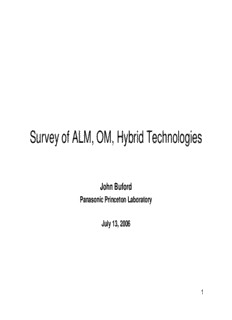
Survey of ALM, OM, and Hybrid Multicast Systems PDF
Preview Survey of ALM, OM, and Hybrid Multicast Systems
Survey of ALM, OM, Hybrid Technologies John Buford Panasonic Princeton Laboratory July 13, 2006 1 Topics • Problem statement • Terminology • ALM • OM • Hybrid • Summary of ALM and OM • Next steps 2 Problem Statement • IP Multicast: • Problem statement – Many possible – Offer more flexible deployment options applications but slow – Accelerate deployment of native multicast deployment • Allow use with incremental deployment • Factors frequently cited: • Enable growth of multicast applications to create market demand to drive business case for – Number of network network upgrade devices that need – Address other dimensions of multicast modification scalability – Inter-domain • Highly dynamic group membership deployment issues • Millions of small groups – Hardware lifetimes – Address other network environments – Global deployment • Concatenated VPNs (I.e., GIG), Mobile Networks requirement – Pricing model – Need for a scalable Mostafa Ammar. Why Johnny inter-domain multicast Can’t Multicast Lessons about routing protocol the Evolution of the Internet. Keynote - NOSDAV 03. 3 Taxomony Multicast IP Multicast Hybrid ALM Host Source Overlay End System Group Specific Multicast Unstructured Structured Multi Destination Overcast Narada PIM-DM SSM XCAST Universal Scribe (Pastry) RMX Yoid PIM-SM Multicast CAN AMCast NICE CBT Bayeux (Tapestry) Scattercast ALMI DVRMP 4 Terminology • Application Layer Multicast – Multicasting functionality is implemented at the application layer, i.e. at the end-hosts instead of the network routers • Overlay Multicast – Construct a backbone overlay by deploying special intermediate proxies, proxies create multicast trees among themselves – End hosts communicate with proxies via unicast or native multicast – (Might this better be called Proxied Overlay Multicast?) • Hybrid Multicast Architecture – Combine ALM and native multicast to provide end-to- end service 5 IP Multicast, ALM, and OM IP Multicast ALM OM L. Lao, J.-H. Cui, M. Gerla and D. Maggiorini. A Comparative Study of Multicast Protocols: Top, Bottom, or In the Middle? in Proceedings of 8th IEEE Global Internet Symposium (GI'05) in conjunction with IEEE INFOCOM'05, Miami, Florida, March 2005. 6 Terminology • Tree creation types – Centralized • Tree manager node collects RTT measurements from group members and computes minimum spanning tree • Limited scalability but good tree quality • Example: ALMI – Mesh-based • Members of a group are connected in a mesh • Tree is formed using conventional routing algorithm over mesh • Need a link evaluation to select links from mesh • Scalability: O(n) state for mesh, but see one-hop DHT designs • Examples: ESM, Scattercast 7 Terminology • Tree creation types – Tree-based • Group members self-organize • Explicitly pick a parent for each new member • Needs loop detection and tree-reconnection • State is O(E) so scalability to large groups • Examples: Yoid, HMTP – Implicit • Creates a control topology with specific properties such as hierarchy or locality • Inherit packet forwarding rule implicitly defines data tree • Examples: NICE, CAN, Scribe/Pastry, Bayeux/Tapestry 8 Terminology • Rendezvous Point (RP) – A designated node for a multicast group which is contacted when a node wants to join that group – Used in centralized and tree-based tree construction types. 9 Terminology - Metrics • Stress: counts the number of identical packets sent by the protocol over that link or node. • Stretch: the ratio of the path length along the overlay from the source to the member to the length of the direct unicast path • Degree: number of edges connecting this node to adjacent nodes in tree • End-to-end delay • Control message overhead • Robustness 10
Description: